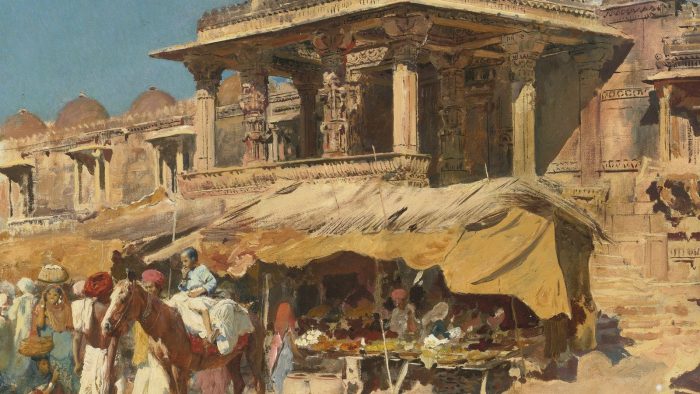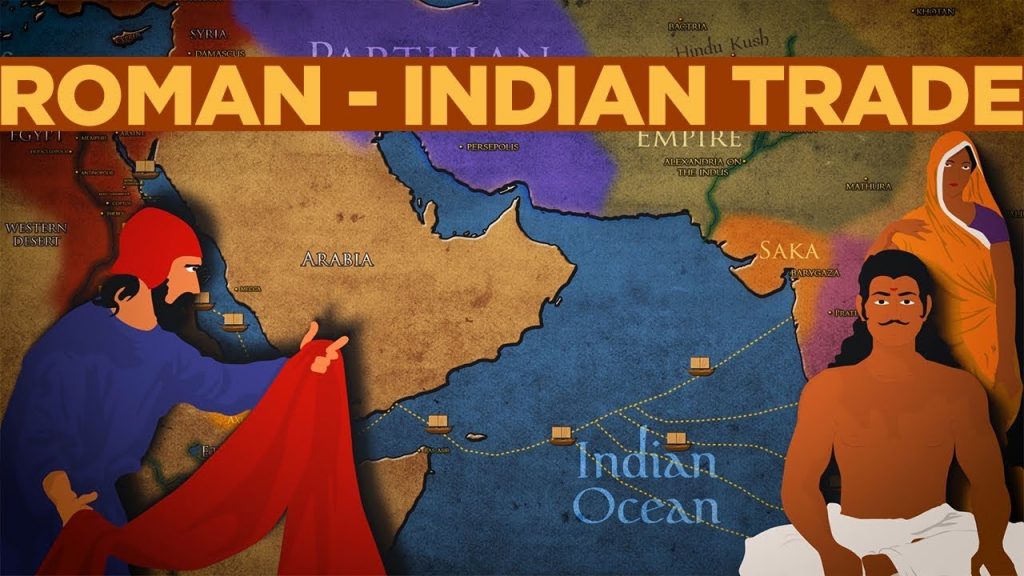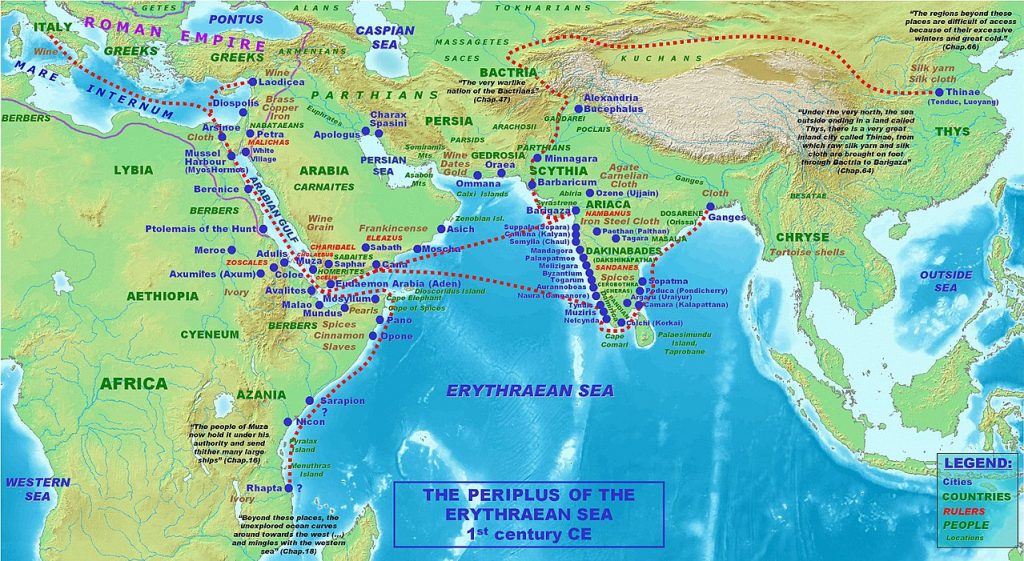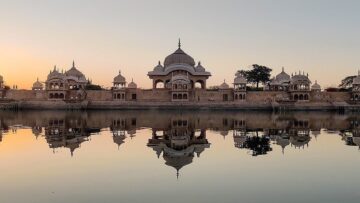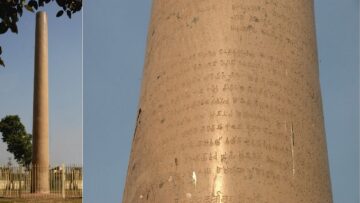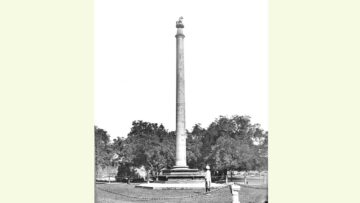Introduction
Exchange networks in India go far deep into time and are as old as the Neolithic Age (9000 BP). During the Sindhu-Sarasvatī Civilisation, these trade networks were further strengthened and expanded and trade was carried out with contemporary cultures like Egypt and Mesopotamia. Inland trade was equally dynamic in this civilisation and was one of the main factors which contributed to its high level of prosperity. Trade declined towards the end of this civilisation but it revived by the 6th century BCE when we witnessed the rise of urbanisation in the Gaṅgā Valley. Though we are not very certain about the exact nature of external trade till the 4th century BCE, internal trade was surely responsible for the rise of cities and the associated phenomena like the emergence of currency, art and public architecture and so on. It was around the 1st century BCE that trade relations were established between India and the Roman Empire. What is noteworthy is that the balance of trade was more or less in India’s favour and Roman gold and silver coins poured into India taking her affluence to greater heights.
The Indo-Roman Trade
Though the Indo-Roman trade started in the 1st century BCE, it truly matured in the 1st and 2nd centuries CE. The geographical location of Arabia, Asia Minor and northeastern Africa helped to establish trade contacts between South Asia, West Asia and Europe. As far as India is concerned, the earliest evidence of this trade is to be found from the southern Peninsula, especially in the state of Kerala. Indo- Roman trade was carried out on the sea as well on land. The seaborne trade was controlled by the Śakas and the Sātavāhanas whereas the land-borne trade was monitored by the Kuśāṇas.
It is believed that to promote foreign trade, Kanīṣka, the Kuṣāṇa ruler made use of the standard of the Roman gold coins for his own issues. The political tensions between the Śakas and Sātavāhanas did affect this trade for some time at least. Similarly, the contentions between the Śakas and Parthians also served as a major impediment for trade overland. In order to overcome this problem, Augustus, the Roman Emperor encouraged the traders to take the sea route and offered them protection as well.
There is a text called Periplus on the Erythrean Sea, a sort of a guide book written by an unknown Greek sailor which is one of the major sources to reconstruct the history of this trade. Indo-Roman trade was mainly in luxury items and the Roman Empire paid for these in Roman gold coins. Chinese goods with the exception of silk were first brought to India and then dispatched to the eastern frontiers of the Roman Empire. Silk was directly sent to Europe along the silk route. Indian animals like tigers, lions, rhinoceroses, elephants and serpents also formed a part of exports from India and these were used in circus shows to entertain the Romans. Ivory and tortoise shells were also exported which were used to inlay furniture. Roman ladies were especially fond of pearls from India and the Persian Gulf. Different kinds of herbs, spices, indigo, cotton cloth, sesame oil, rice, wood for furniture and plant products from India were also in great demand in the Roman markets.
The city of Bharuch or ancient Bhṛgukachcha was well known for its exports of wheat and ghee. Like pearls, precious and semi-precious stones like diamonds, onyx, sardonyx, agate, carnelian, crystal, amethyst, opal, cat’s eye, ruby, turquoise and garnet were also popular among the Romans, especially the ladies. In the category of imports from Rome, wine topped the list. It was called Vāruṇi as it was brought from the sea in specially designed carriers which were called Amphorae. Roman Amphorae have been discovered at many sites in peninsular India including Nevasa in Maharashtra. As the Romans had to pay for Indian products in gold, there was a huge strain on their economy. Tiberius, the Roman Emperor who ruled in the 1st century CE attempted to stop the outflow of Roman gold but to no avail.
The discovery of the south-west monsoon winds is credited to a Greek navigator named Hippalus who probably lived in the 1st century BCE. However, some scholars argue that these winds were known to sailors even before the 1st century BCE. The seaborne journey from Rome to the western coast of India approximately took sixteen weeks and the ships began their sojourn from the Mussel Harbour coinciding with the winter equinox. Some Roman merchants would commence their journeys from Myos Hormos or Berenice (in Egypt). Ocelis at the mouth of the Red Sea was the terminating point for exchanging commodities as the Arabs did not allow the Indian merchants to travel further. In spite of this restriction, much of the Indo-Roman trade was under the control of Indian merchants.
Barbaricum (probably a port near modern Karachi) was an important port on this route and it was from here that the ships travelled to the coast of Saurāṣṭra and from there to Bhṛgukachcha or modern Bharuch in Gujarat near the mouth of the river Narmada. This arrangement was made because the sea near Bharuch was difficult to navigate as the seafloor was rocky and sharp. The ships would first go to the coast of Saurāṣṭra and from there the fishermen in the king’s service (a Kṣatrapa ruler) would guide the ships to Bharuch.
Apart from wine, the other goods which were imported to Bharuch were copper, tin, lead, coral, topaz and waist girdles. The Roman merchants also brought expensive merchandise like silverware, wine, good quality cloth and ointments as gifts for Indian rulers. Bharuch also exported fragrant ointments and ivory to Rome. Bharuch had trade relations with two inland cites- ancient Pratiṣṭhāna or modern Paithana and Tagara or Ter, both in Maharashtra. The Periplus on the Erythrean Sea informs that the journey from Bharuch to Paithana would take twenty days and Ter was at a further distance of ten days from Paithana. Both Paithana and Ter were well known for the export of carnelian, muslin and mallow cloth. Ter and Paithana were also a part of the southern trade routes.
One route originated from Masulipattanam and the other from Vinukonda (both in Andhra Pradesh) and these two routes met near the modern city of Hyderabad. As this route proceeded northwards, it passed through Ter, Paithana, Devagiri and the Ajanta ranges. It crossed the Western Ghats and reached Kalyana near Mumbai which was the last destination of this route. However, due to the long-drawn conflict between the Sātavāhana ruler Gautamiputra Sātakarṇi and the Kṣatrapa king Nahāpāna in the 1st century CE, the trade route was diverted to Bharuch.
The Periplus on the Erythrean Sea tells us that the ports of Sopara and Kalyana were very strategic for the Indo-Roman trade. Sopara also features in Buddhist lore, apart from Hindu and Jaina literature and was home to a large Buddhist monastery. Inscriptions of Emperor Aśoka and a Sātavāhana period stupa are the principal remains found in Sopara apart from numerous other antiquities. Following these two major ports in northern Konkan or Aparanta, the Periplus on the Erythrean Sea gives a detailed list of ports on the western coast of India. South of Kalyana was Chemula (Chaul), Mandragora (Mandad near the Kuda Caves), Palaepatmae (Dabhol), Melizigara (Jaigarh), Tosarum (Deogarh) and Arranoboas (Malvan). Further south he mentions an island called Sesecrienae which is identified with the rocks at Vengurla and Aegedi (Goa or Anjidvipa).
Moving further southward the text makes a reference to Karwar or Chersonesas where there was a fear of pirates. The port of Muziris is mentioned as a prominent port but it has not been accurately identified. Some scholars identify it with Craganore but this identification is not beyond doubt. Arab and Greek ships which were full of goods were anchored at Muziris. Here there was an active exchange of Indian and Roman goods. There was also inland trade route which started at Muziris, went through Palakkad and running parallel to the River Kāverī it reached the eastern coast. A few years ago excavations were carried out by the Kerala Council of Historical Research at a village called Pattanam which was considered to be the site of Muziris. A large hoard of Roman coins, Roman glass fragments, Amphorae and objects related to the bead manufacturing industry were among the main finds. Historian Rajan Gurukkal is of the view that Pattanam was a colony of the merchants from the Mediterranean region and this site may not be the same as Muziris.
Kerala or Cerabothra was well known for its export of black pepper. Moving eastward, pearl fisheries in the Gulf of Mannar were controlled by the Pāṇdya rulers of Madurai. We have already stated that Indian pearls were liked by Roman ladies. Further north in the territory of the Colas known as Colamaṇḍala there is a port called Kaveripattanam or Puhar situated at the mouth of the northern branch of the Kāverī. This port has been mentioned in Tamil literature with descriptions of ships anchored there and the colonies of the Yavanas. Other important ports further north were Poduca (Pondicherry) and Sopatma. Excavations carried out at the site of Arikamedu near Pondicherry have revealed that this too was a prosperous centre for Indo-Roman Trade in the 1st century CE. Here pottery having the names of families who manufactured it in Rome was unearthed apart from other finds.
Sopatma has been identified with Marakanam which is situated between Pondicherry and Chennai. Masalia or Masulipattanam in Andhra Pradesh was a flourishing city and a major centre for trade known for its export of muslin. The Periplus also names Dosarene or Tośalī in Odisha as a trade centre specialising in the export of ivory. In Bengal, the port of Tāmralipti or Tamluk was the chief trade centre since very early times and was known for its exports of god quality muslin cloth and tortoise shells.
The Indo-Roman trade brought in unprecedented levels of prosperity for the Indian rulers and the merchant classes. One of the most conspicuous impacts of this was the growth of numerous Buddhist monasteries in western Maharashtra. Most of these monasteries were located along major trade routes and received magnanimous donations from Indian and foreign merchants. E.g. : The Caityaghara at Karle was excavated with the help of the gift of a merchant called Bhutapāla from Banavāsī. The contact with the west also found reflection in art. Griffins and Sphinx were commonly sculpted at these cave complexes. The double-humped Bactrian camel which is not indigenous to India has been carved in the caves at Kanheri and Nasik. This was because of trade contacts. The monasteries themselves seemed open to the depiction of these foreign motifs though they had no connection as such with Buddhism. Indians also manufactured goods by emulating the Roman ones. Lamps of Indian make which resembled Roman lamps were found in large numbers at Ter. The Sātavāhana ruler Yajñaśri Sātakarṇi issued coins with the image of a large ship which is a clear indication of the maritime trade encouraged by the Sātavāhanas and the importance of this trade in the contemporary economy.
Conclusion
The Indo-Roman trade was very strong in ancient times including the Saraswati and Indus valley civilisation and began to drastically decline only after the fall of the Roman Empire in the 4th century CE. The volume of trade had already begun to diminish from the end of the 2nd century CE onward. The end of the Sātavāhana and Kuṣāṇa Empires in the early 3rd century CE also contributed to the waning of the Indo-Roman trade. However, in the Gupta period, India began to have close trade ties with South East Asia. Nevertheless, the paradigm of Indo-Roman trade will always be remembered as a golden page in the history of India.
References:
- Chandra Moti, Trade and Trade Routes in Ancient India. New Delhi: Abhinav Publications, 1977
(Do read Ancient Indian Economy Part I, Part II, Part III & Part IV )
Disclaimer: The opinions expressed in this article belong to the author. Indic Today is neither responsible nor liable for the accuracy, completeness, suitability, or validity of any information in the article.

